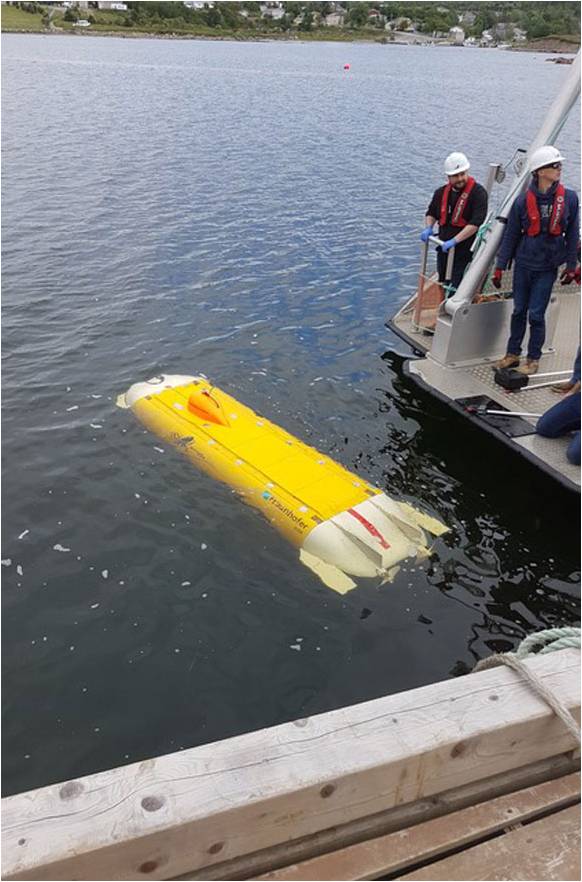Our oceans and deep-sea spaces remain a mystery – more people have walked on the moon than have journeyed to the bottom of the ocean.
 Kraken Sonar Systems ThunderFish® Underwater Autonomous Vehicle (AUV), equipped with leading edge Aquapix® sonar system, delivers military-grade imagery for use in surveying ocean seabeds and underwater objects. NRC-IRAP support was instrumental in helping the company successfully adapt and develop its imaging technologies and robotic delivery systems to provide game-changing performance at accessible prices for multiple applications.
Kraken Sonar Systems ThunderFish® Underwater Autonomous Vehicle (AUV), equipped with leading edge Aquapix® sonar system, delivers military-grade imagery for use in surveying ocean seabeds and underwater objects. NRC-IRAP support was instrumental in helping the company successfully adapt and develop its imaging technologies and robotic delivery systems to provide game-changing performance at accessible prices for multiple applications.
Named for the mythical sea creature eulogized by Jules Verne, Kraken Sonar Systems Inc., of St. John’s, Newfoundland, is scoring commercial success by unlocking the secrets of our coastlines and oceans with leading-edge underwater imaging technology.
With the help of the National Research Council of Canada Industrial Research Assistance Program (NRC-IRAP), Kraken has deftly combined its business and research strategies to be a market leader in underwater sensors and robotics. AquaPix® is an industry leading Synthetic Aperture Sonar (SAS) system that provides military-grade technology to enable superior 3D seabed imaging and mapping, faster data processing, and a lower cost than competing sonars.
Kraken, founded in 2012, is renowned for its role in finding the wreck of the Franklin Expedition in Nunavut in 2014 and 2015, and more recently for the hunt for the prototypes of the Avro Arrow in Lake Ontario. The company is landing international business and government contracts for strategic underwater mapping, environmental research, mining, oil and gas exploration, and salvage operations.
Strategic advice leads to tech game changer
Karl Kenny, President and CEO of Kraken, first came across SAS while visiting the NATO Undersea Research Centre in La Spezia, Italy in 2010.
Sonar technology and SAS transform sound waves into images. SAS supersedes earlier technology to provide 25 times greater resolution and a 300% increase in area coverage. Kraken’s AquaPix® takes SAS to the next level, with ultra-high resolution interferometric synthetic aperture sonar (InSAS) and 3D bathymetric capabilities that measure the depth and shape of the ocean floor.
“SAS was very expensive, but I realized it could be a game changer in underwater imaging,” recalled Kenny. “The key was to reduce its cost by moving from a hardware-centric to a software-centric approach. It was a pretty risky thing to try.”
In 2012, Kraken turned to IRAP for help with its R&D strategy – a move that took its research program in a surprising direction. Stephen Manley, an Industrial Technology Advisor (ITA) from IRAP, quickly saw the potential to adapt gaming technology to sonar applications. “It was like looking into a crystal ball and making a big bet on where the technologies would converge three years down the road,” explained Kenny.
“By adapting standard off-the-shelf graphics processing cards, we’ve been able to do on-the-fly, real-time sonar processing and gain a real cost advantage over our competitors. This approach opens the door to continuous innovation.”
IRAP also helped the company develop a multi-year growth strategy. “The goal was to go beyond creating a disruptive advance in SAS technology – to offer clients a complete ecosystem ready to collect and process the data for a clear undersea image,” said Manley.
The result was a series of projects supported by IRAP to develop the company’s core sonar technology, as well as the correlation velocity logs, geo-referencing, and registration systems that enable its real-time processing and mapping capabilities. IRAP support also enabled Kraken to hire the engineers, technicians, and software developers needed to create its fleet of intelligent towed (KATFISH™) and autonomous underwater vehicles (ThunderFish®) that can successfully deploy and deliver its imaging technology from underwater depths.
“IRAP has been with us every step of the way,” said Kenny. “ITAs understand the technology and what we are doing. It’s been great to have their critical assessment. These are multimillion-dollar projects. The more eyes you have on them, the better your chances of succeeding.”
A big risk pays off
“IRAP’s contributions have built upon each other like a jigsaw puzzle,” said Kenny. “Now we can go out and offer a world-class capability.”
Kraken’s revenues are growing every year. In 2016, revenues exceeded $2 million. In five short years the staff has grown from 6 to 40, with a strong and growing team of technical experts.
The mystery of the oceans awaits. Kenny believes the ocean survey industry is poised for incredible growth, and that Kraken can shake things up by doing it better, faster, and cheaper.
“IRAP is a fantastic enabler. I think it’s one of the best programs in the country”, concluded Kenny.
“IRAP’s contributions have built upon each other like a jigsaw puzzle. Now we can go out and offer a world-class capability.”
Karl Kenny, CEO, Kraken Sonar Systems
Originally pulished on National Research Council Canada Website https://www.nrc-cnrc.gc.ca/eng/irap/success/2017/kraken_sonar.html

